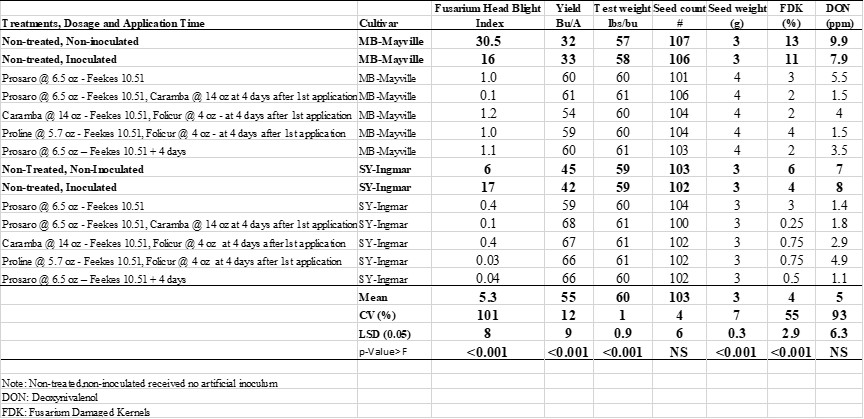Objective: To evaluate the efficacy of fungicides in single and sequential applications to manage Fusarium head blight (FHB) in hard red spring wheat (HRSW).
Methods:
Location: NDSU Langdon Research Extension Center.
Experimental Design: Randomized complete block with split plot arrangement, four replications.
Previous crop: Soybean
Cultivars of HRSW tested: WB Mayville and SY Ingmar
Planting: 1.2 million pure live seeds/A planted on May 5, 2017. A border plot was planted between treated plots to minimize interference from spray drift.
Plot size: Seven rows at six inch spacing, 5 ft. x 20 ft., mowed back to 5 ft. x 16 ft.
Herbicides Applied: Axial XL (16.4 Fl. oz/A) + Huskie (15 Fl. oz/A) + Prowl H2O (36 Fl. oz/A)
Inoculation: Plots were inoculated by spreading corn spawn inoculum at around boot stage (Feekes 9-10) at the rate of 300 g/plot.
Disease development: Supplemental moisture was provided by running overhead irrigation from Feekes 9 to 11.25 at the rate of one hour per day to create a conducive environment for FHB development.
Fungicide treatments: Fungicides were applied, with a CO2-pressurized backpack sprayer with a three nozzle boom (XR-8002) and the water volume used was 20 GPA. Fungicide application was made at Feekes 10.51(anthesis) on July 7 and repeated 4 days after the first spray (July 13, 2017). Refer to Table 1 for the treatments, dosages and application timings.
Disease Assessment: Data on FHB incidence was obtained by counting the number of heads showing FHB symptoms out of 50 heads. FHB head severity was rated using 0-100% scale on arbitrary 50 heads, excluding two outer rows. FHB index (Index) was calculated using formula: Index = (SEV*INC)/100.
Harvest: Plots were harvested on August 24 with a small plot combine and the yield was determined.
Data Analysis: Statistical analysis was done using SAS. Fisher’s least significant difference (LSD) was used to compare means at p (α = 0.05). Actual means are presented in the table for simplicity of understanding.
Results:
The HRSW Cultivar “WB-Mayville” is significantly different from the cultivar “SY-Ingmar” in all the parameters tested in the current research trial. On the cultivar “WB-Mayville;” all the fungicide treated treatments are significantly different from both checks when compared with the parameters tested. Similarly, on the HRSW cultivar “SY-Ingmar” both the checks are significantly different than the fungicide treatments. The treatment Proline at anthesis and folicur at 4 days after anthesis has low FHB Index (0.03), and higher DON (4.9 ppm). Whereas, the treatment Prosaro at anthesis and 4 days after anthesis with FHB Index of 0.04 and lower DON (1.1 ppm) content when compared with all the treatments of the trial. However, there were no significant differences in yields, test weights, seed count, FDK parameters among the fungicide treatments and were significant to the non-treated inoculated and non-treated non-inoculated checks.
Table 1: Fungicides tested alone and in combinations on two HRSW varieties at two application timings to manage Fusarium head blight and evaluation of their influence on yield and other grain characteristics: toxin (DON) content, FDK, and test weight.
Acknowledgements: Bryan Hanson, Travis Hakanson and Lawrence Henry for their technical support and USWBSI for funding.
